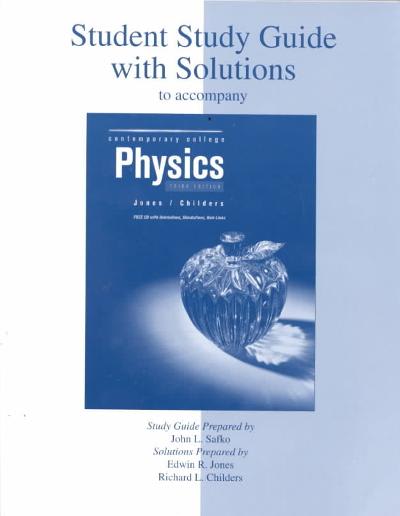Question
please answer these questions please answer the part 1 and part 2 Go to the website: https://phet.colorado.edu/sims/html/masses-and-springs-basics/latest/masses-and-springs-basics_en.html Objectives: 1. To investigate Hooke's law 2. To
please answer these questions
please answer the part 1 and part 2
Go to the website:https://phet.colorado.edu/sims/html/masses-and-springs-basics/latest/masses-and-springs-basics_en.html
Objectives:
1. To investigate Hooke's law
2. To determine the spring constant of a spring graphically and analytically
3. To use Hooke's law to determine unknown masses hung on a spring
Apparatus:
PhET Simulation: Masses and Springs
Theory:
Hooke's law is a significant and widely-used law in physics and engineering, and its applications go far beyond springs. Mainly, Hooke's law states that the extension of a spring, whether it is a compression or an expansion, is directly proportional to the applied force.
If a spring obeys Hooke's law, then a graph of the applied force
against extension will be a straight line whose slope is k: the spring
constant. Therefore, to graphically determine the spring constant of a
spring, the slope of the force versus extension graph must be calculated.
Hooke's law is represented by the straight-line equation:F = kx where: F = the applied force (N)
k = the spring constant (N/m)
x = the extension of the spring (m)
To analytically determine the spring constant of a spring, Hooke's law must be solved for k. The equation yieldsk=Fx.
Procedure:
Open the following link and click the lab option:https://phet.colorado.edu/sims/html/masses-and-springs-basics/latest/masses-and-springs-basics_en.html
Part 1: Investigating Hooke's Law and Determining the Spring Constant
1. Check the 'Displacement' and 'Movable Line' options in the box to the right. 2. Slide the 'Damping' option to 'Lots'; this will help in stopping the spring from springing back to its relaxed position.
3. Slide the 'Mass' option to 50g and place the mass onto the spring.
4. Once the spring stops oscillating, place the dotted red line just below the tip of the green arrow.
5. Use the ruler tool to measure the extension of the spring from the blue line to the red line.
6. The ruler gives measurements in (cm); convert the extension to (m) and record it in table 1.
7. Convert the mass to (kg) and calculate its weight by multiplying it by 9.8 m/s2. Record the weight in table 1.
8. Repeat the experiment for the 100g and 250g masses and record your findings in table 1.
Table 1
| Mass (g) | Mass (kg) | Weight (N) | Extension (m) |
| 50 | |||
| 100 | |||
| 250 |
a) Using Microsoft Excel, plot a graph of force (weight) versus extension and insert it below. Note: Force (N) is plotted on the y-axis, and extension (m) is plotted on the x axis.
b) From the graph, determine the value of the spring constant (in N/m).
c) Calculate the value of the spring constant (in N/m) for the 3 trials using Hooke's Law. Calculate the average value of k.
d) What is the relationship between force and extension?
e) What evidence from the graph proves your answer to part c?
f) Does the value of the spring constant for one spring vary with the magnitude of the force acting on it?
g) write definition for the spring constant (k).
Part 2: Determining Unknown Masses Hung on a Spring
Using the average value for the spring constant you calculated using Hooke's Law, work backwards to find the masses of the red and blue hangers in the simulation and record them in table 2 (g = 9.8 m/s2).
Table 2
| Mass Color | Spring Constant (N/m) | Extension (m) | Weight (N) | Mass (kg) |
| red | ||||
| blue |
Questions:
- A spring extends by 20 cm when a force of 2 N is applied. What is the value of the spring constant in N/m?
- A spring extends by 5 cm when a force of 20 N is applied to it. What force would be needed to extend the spring by 10 cm?
Step by Step Solution
There are 3 Steps involved in it
Step: 1

Get Instant Access to Expert-Tailored Solutions
See step-by-step solutions with expert insights and AI powered tools for academic success
Step: 2

Step: 3

Ace Your Homework with AI
Get the answers you need in no time with our AI-driven, step-by-step assistance
Get Started


